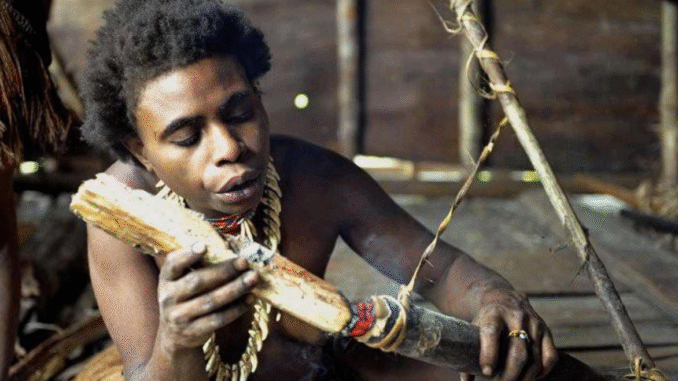Lifestyle-Health
World Most Dangerous Places Where Cannibalism Is Still Done Till Date

Cannibalism is one of those acts that human beings have never been known to engage in for a number of reasons. However, this does not mean that cannibalism does not exist; on our planet, there are still a few locations where it is openly practiced in some communities.
Papua New Guinea, the Nahe Caves, the Ganges, and Cambodia are among the rare countries that do not mind eating humans while they are still alive. Cannibalism is caused by religious rituals the vast majority of the time; nevertheless, humans can also become cannibals as a result of being driven to it by extreme circumstances.
The following are some locations that you should avoid going to if you don’t want to end up in the stomach of another person.
PNG, or Papua New Guinea
In western New Guinea, on the banks of the Ndeiram Kabur River, there is a tribe known as the Korowai who are rumored to practice cannibalism. The Korowai people are notorious for engaging in activities that are totally alien to humans and utterly unique to their culture. They subsist on human flesh and make their home in trees that may reach heights of up to 140 feet.
Cannibalism is at the top of the list of strange practices practiced by the Korowai, thus this makes perfect sense. They were certain that the devil, whom they referred to as “Khakua,” existed in their world. Korowe is of the opinion that any unexplained death that occurs within the town is the result of an attack by a demon, which then resulted to the death of the individual who was attacked.
The Korowai believe that it is their responsibility to scavenge the bodies of the deceased in order to get revenge on the Kaku. As a result of the tribe’s practice of devouring the flesh of the mysteriously deceased, they evolved into cannibals quite quickly.
Naihehe Cave, located in Sigatoka, Fiji, is rumored to be the stronghold of a clan of cannibals who are known for their brutality. Because the island was inhabited by cannibal tribes, it became known as “Cannibal Island” due to the widespread fear they caused. In Fiji’s lengthy and seemingly endless history, cannibals have played a prominent role.
In contrast to the Korowai, the dwellers of the Naihehe cave do not require theological justification in order to consume human flesh. During their festivals, members of the Nehehe cave tribe partake in the hunting of people and taste meat lollipops made from human flesh.
During the festivities, they enjoyed dancing to traditional tunes, drinking unusual beverages, and dining on delectable cuts of human flesh. Be sure to plan your trip to the island of cannibals in Fiji for the appropriate time of year.
Ganges cannibals
Cannibalism has nearly completely disappeared from India. On the other hand, the fact that some monks continue to believe in and engage in the practice of cannibalism may come as a shock to you. The legendary cannibal organization known as the “Aghori” propagates the concept that participating in cannibal rites enables one to achieve a higher level of spiritual consciousness.
Aghoris consume human skulls for both food and drink, and they cover their bodies with the burnt skin of humans. Although the Aghori ceremonies might give you the creeps, Indians have found a way to live in harmony with them. To our good fortune, Aghoris do not prey on humans.
They favor making use of the bodies of individuals who have already passed away. Aghori are feared by Indians both because to the fact that it is impossible to overlook the fact that they consume human beings and because they are thought to be masters of witchcraft.
The Democratic Republic of the Congo, also known simply as DRC, is a nation on the continent of Africa.
In the 2000s, insurgents from the Congo went on the hunt for members of the Bambuti tribe. As a result of several different human rights efforts, cannibalism has been illegal in the Democratic Republic of the Congo for a very long time. However, a few years ago, representatives of the Congolese minority appealed the government for help when presenting at a United Nations convention. At the time, members of the minority had inexplicably vanished.
In the 2000s, it was claimed that Congolese insurgents started attacking members of the Congolese Mbuti Pygmy community. At a United Nations meeting in 2003, Mbuti Pygmies represented Sinafasi Makelo and brought attention to the genocide that had been committed against minorities, in addition to other issues such as sexual assault, abuse, and poverty.
A later decision was made to practice cannibalism by members of an armed group who believed that consuming the human flesh of members of the Bambuti tribe would bestow upon them the ability to perform supernatural feats. It was confirmed by the representative that members of armed groups feed on sexual organs in order to achieve occult powers as their primary motivation.
The cannibalism that ensued as a result of the genocide in Cambodia
The dictatorship of the Khmer Rouge in Cambodia is often regarded as one of the most violent periods in human history. The crimes committed by members of the military forces are beyond description; not only do they kill and dismember civilians, but they also sometimes eat them. In 2003, when it became public knowledge that Khmer Rouge soldiers had tortured detainees by performing caesarean sections or amputating limbs, the prosecution of the decades-long Khmer Rouge case got underway. To instill fear among the other captives, Khmer Rouge soldiers were known to consume the flesh of their victims.
The island of Nuku Hiva, located in French Polynesia
In 2011, it was alleged that a German tourist was murdered, dismembered, and then eaten by his attackers. A German traveler named Stefan Ramin, who was 40 years old at the time, traveled to the remote island of Nuku Hiva in French Polynesia with his fiancée in search of excitement. On the other hand, Lamin was completely unaware that he was going to be the subject of news articles because of the trip.
During their quest for goat in Nuku Shiwa, Ramin and his girlfriend were attacked by their guide. It was later determined that Ramin had been murdered, and his body was discovered close to the campfire. It is speculated that Lamin’s tour guide was the one who murdered him and “cut him to pieces” afterward. The body of Lamin was ultimately reduced to ashes during the burning process. Cannibals attacked a visitor on the island of Nuku Hiva, which led to the island’s rise to infamy.
-

 News In Diaspora3 months ago
News In Diaspora3 months agoHotels and homes on Crete evacuated as wildfire burns out of control
-

 Lifestyle-Health3 months ago
Lifestyle-Health3 months agoInvesting ₹10,000 a month via SIP in this mutual fund would have swelled to ₹1.71 crore in 21 years. Check how
-

 Lifestyle-Health3 weeks ago
Lifestyle-Health3 weeks ago11 signs of growth that you might have missed
-

 Politics4 months ago
Politics4 months agoFinally Federal Government of Nigeria Assures Citizens, Says The President Isn’t Controlled by Any Cabal
-

 Lifestyle-Health3 months ago
Lifestyle-Health3 months agoMultibagger small-cap stock under ₹50 jumps despite sell-off in Indian stock market
-

 Lifestyle-Health3 months ago
Lifestyle-Health3 months agoDriving Abroad: These 34 countries accept SA licenses
-

 Lifestyle-Health1 month ago
Lifestyle-Health1 month agoWhen to take time off and focus on yourself and your family
-

 Lifestyle-Health4 weeks ago
Lifestyle-Health4 weeks agoNatural Drinks That You Should Be Consuming On A Regular Basis To Stay Healthy Once You Turn 40
-

 Breaking News2 weeks ago
Breaking News2 weeks agoVeteran actress, Peju Ogunmola, loses only child, Ayomikun
-

 Lifestyle-Health3 months ago
Lifestyle-Health3 months agoAyala, UPC Renewables JV to sell stake in 1 GW projects in $600 mn deal
-

 Lifestyle-Health4 months ago
Lifestyle-Health4 months agoOgie Alcasid’s daughter Leila ties the knot in Australia
-

 Breaking News4 weeks ago
Breaking News4 weeks agoFire guts Accra High School’s computer lab

